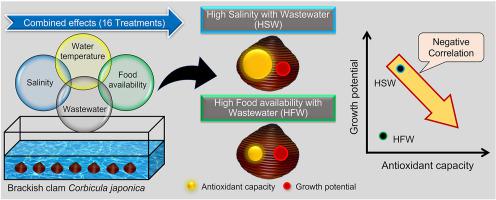Environmental Pollution ( IF 8.9 ) Pub Date : 2022-06-23 , DOI: 10.1016/j.envpol.2022.119676 Preeti Pokhrel 1 , Sayaka Mashiko 1 , Shumona Akther 1 , Jumpei Suzuki 2 , Masafumi Fujita 3

|
Changes in natural estuarine environment and anthropogenic disturbances are becoming significant threats to organisms, particularly bivalves. A deeper understanding of the relationship between biochemical- and individual-level responses is necessary to assess the combined effects of natural and anthropogenic factors on bivalves. To the best of our knowledge, this is the first study where the oxygen radical absorbance capacity (ORAC) and carbon-based scope for growth (C-SFG) were applied as biomarkers to evaluate the response of the brackish water clam Corbicula japonica to four spatiotemporally varying environmental factors. High water temperature and food availability supported C-SFG while high salinity inhibited it. Most of wastewater (WW) treatments resulted in negative C-SFG values because of a reduced clearance rate and increased excretion rate. In particular, high food availability with WW treatment resulted in the lowest C-SFG value of −114 μg C·ind−1 h−1. The ORAC was activated in response to high salinity with WW treatment (p < 0.05). To ascertain the combined effects of the natural and anthropogenic factors, principal component and cluster analyses were performed on the ORAC and C-SFG data. Anthropogenic WW was found to have different effects on the physiological and biochemical biomarkers according to the natural conditions. A roughly negative correlation was observed between ORAC and C-SFG because activation of the antioxidant capacity can influence the growth potential of the clams through the additional use of available metabolic energy. However, some exceptions were observed where both the ORAC and C-SFG values were either high or low, which could be because the C-SFG response varies depending on different metabolic behaviors even when the ORAC response remains the same. These results indicate that the biochemical-level response (i.e., ORAC) of C. japonica can be interpreted using individual-level response (i.e., C-SFG), but careful attention must be given to over- or underestimation.
中文翻译:

自然和人为因素共同作用下咸水蚬生长的抗氧化能力和碳基范围
自然河口环境的变化和人为干扰正在成为对生物体,尤其是双壳类动物的重大威胁。有必要更深入地了解生化和个体水平反应之间的关系,以评估自然和人为因素对双壳类动物的综合影响。据我们所知,这是第一项应用氧自由基吸收能力 (ORAC) 和碳基生长范围 (C-SFG) 作为生物标志物来评估咸水蚌Corbicula japonica反应的研究四个时空变化的环境因素。高水温和食物供应支持 C-SFG,而高盐度抑制它。由于清除率降低和排泄率增加,大多数废水 (WW) 处理导致 C-SFG 值为负。特别是,WW 处理的高食物利用率导致最低的 C-SFG 值 -114 μg C·ind -1 h -1。ORAC 响应于 WW 处理的高盐度而被激活(p < 0.05)。为了确定自然和人为因素的综合影响,对 ORAC 和 C-SFG 数据进行了主成分和聚类分析。根据自然条件,发现人为WW对生理生化生物标志物具有不同的影响。在 ORAC 和 C-SFG 之间观察到大致负相关,因为抗氧化能力的激活可以通过额外使用可用的代谢能量来影响蛤蜊的生长潜力。然而,观察到 ORAC 和 C-SFG 值高或低的一些例外情况,这可能是因为即使 ORAC 反应保持不变,C-SFG 反应也会根据不同的代谢行为而变化。这些结果表明,生化水平的反应(即 ORAC)C. japonica可以使用个体水平的反应(即 C-SFG)来解释,但必须仔细注意高估或低估。



























 京公网安备 11010802027423号
京公网安备 11010802027423号